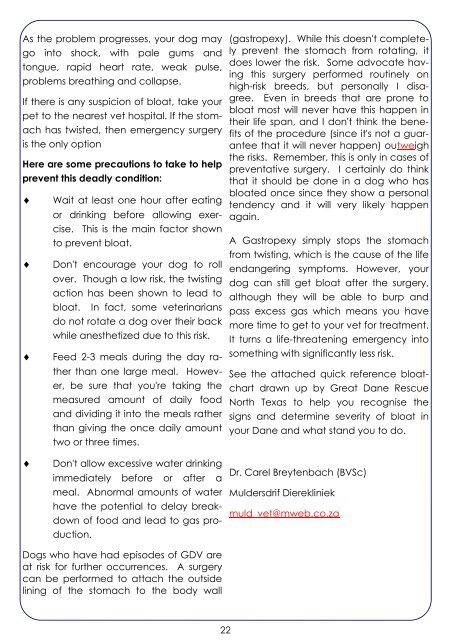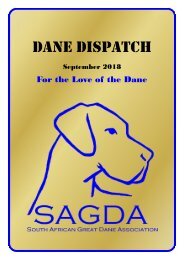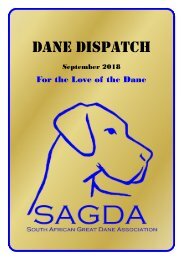Dane DispatchNov2017
Create successful ePaper yourself
Turn your PDF publications into a flip-book with our unique Google optimized e-Paper software.
As the problem progresses, your dog may<br />
go into shock, with pale gums and<br />
tongue, rapid heart rate, weak pulse,<br />
problems breathing and collapse.<br />
If there is any suspicion of bloat, take your<br />
pet to the nearest vet hospital. If the stomach<br />
has twisted, then emergency surgery<br />
is the only option<br />
Here are some precautions to take to help<br />
prevent this deadly condition:<br />
<br />
<br />
<br />
Wait at least one hour after eating<br />
or drinking before allowing exercise.<br />
This is the main factor shown<br />
to prevent bloat.<br />
Don't encourage your dog to roll<br />
over. Though a low risk, the twisting<br />
action has been shown to lead to<br />
bloat.<br />
In fact, some veterinarians<br />
do not rotate a dog over their back<br />
while anesthetized due to this risk.<br />
Feed 2-3 meals during the day rather<br />
than one large meal. However,<br />
be sure that you're taking the<br />
measured amount of daily food<br />
and dividing it into the meals rather<br />
than giving the once daily amount<br />
two or three times.<br />
(gastropexy). While this doesn't completely<br />
prevent the stomach from rotating, it<br />
does lower the risk. Some advocate having<br />
this surgery performed routinely on<br />
high-risk breeds, but personally I disagree.<br />
Even in breeds that are prone to<br />
bloat most will never have this happen in<br />
their life span, and I don't think the benefits<br />
of the procedure (since it's not a guarantee<br />
that it will never happen) outweigh<br />
the risks. Remember, this is only in cases of<br />
preventative surgery. I certainly do think<br />
that it should be done in a dog who has<br />
bloated once since they show a personal<br />
tendency and it will very likely happen<br />
again.<br />
A Gastropexy simply stops the stomach<br />
from twisting, which is the cause of the life<br />
endangering symptoms. However, your<br />
dog can still get bloat after the surgery,<br />
although they will be able to burp and<br />
pass excess gas which means you have<br />
more time to get to your vet for treatment.<br />
It turns a life-threatening emergency into<br />
something with significantly less risk.<br />
See the attached quick reference bloatchart<br />
drawn up by Great <strong>Dane</strong> Rescue<br />
North Texas to help you recognise the<br />
signs and determine severity of bloat in<br />
your <strong>Dane</strong> and what stand you to do.<br />
<br />
Don't allow excessive water drinking<br />
immediately before or after a<br />
meal. Abnormal amounts of water<br />
have the potential to delay breakdown<br />
of food and lead to gas production.<br />
Dr. Carel Breytenbach (BVSc)<br />
Muldersdrif Dierekliniek<br />
muld_vet@mweb.co.za<br />
Dogs who have had episodes of GDV are<br />
at risk for further occurrences. A surgery<br />
can be performed to attach the outside<br />
lining of the stomach to the body wall<br />
22




